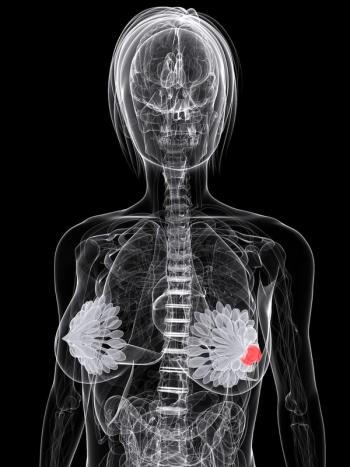
Novel Intratumoral Formulation Shows Responses/Safety in Metastatic Cancers
A unique cisplatin-containing intratumoral formulation achieved a median OS of 18.7 months in patients who were dosed at 40% or more of their TTB.
Intratumoral INT230-6 achieved a positive disease control rate (DCR) and overall survival (OS), and was well tolerated, in patients with various advanced or metastatic cancer types, according to data from a single-arm phase 1/2 trial (NCT03058289) published in eBioMedicine.1
INT230-6 is a unique intratumoral formulation of cisplatin, vinblastine, and 8-((2-hydroxybenzoyl)amino)octanoate (SHAO).
In all patients who received more than 1 dose of INT230-6 (n = 64), the DCR was 75.0% (95% CI, 62.6%-85.0%). In patients who were dosed at 40% or more of their total tumor burden (TTB; n = 48), the DCR was 83.3%, with 2 patients (4.2%) achieving a partial response (PR) and 38 (79.2%) having stable disease. Among patients dosed at less than 40% of their TTB (n = 16), the DCR was 50%, with all cases being stable disease. When excluding the 3 patients with a TTB greater than 1125 cm3 from the group dosed at less than 40% TTB, the DCR was 47%.
The median OS in all treated patients was 11.9 months (95% CI, 6.3-19.4); 15 patients survived for at least 21 months, with 8 still being alive at the end of the study. Among those dosed at 40% or more of their TTB, the median OS was 18.7 months (95% CI, 11.5-23.5) vs 3.1 months (95% CI, 1.6-5.9) in those with less than 40% of their TTB (HR, 0.17; 95% CI, 0.081-0.342; P <.0001).
When the 3 patients with a TTB greater than 1125 cm3 were excluded from the survival analysis, the median OS in the all-treated population was 13.4 months (95% CI, 7.3-21.3). For patients dosed at less than 40% TTB, the median OS was 3.2 months (95% CI, 1.6-6.0). Notably, patients dosed at 40% or more TTB had improved survival vs patients dosed at less than 40% across various low to high TTB and tumor sizes.
In patients with sarcoma who progressed on a median of 3 lines of therapy (n = 15), the median OS was 21.3 months (95% CI, 4.7-not attained [NA]). Those with sarcoma dosed at 40% or more of their TTB had a median OS that was not reached at a median follow-up of 21.4 months (95% CI, 4.7-NA). For those dosed at less than 40% of TTB, the median OS was 4.02 months (95% CI, 3.2-NA).
"INT230-6 is a local treatment that kills cancer using a diffusion process following direct injection into tumors. The trial demonstrated favorable safety and promising efficacy in patients with advanced metastatic cancers who had [progressed on] a median of 3 prior lines of therapy. The DCRs and median survival compare favorably to those historically seen for such a diverse set of refractory cancer types in a phase 1/2 study," stated first author Jacob S. Thomas, MD, assistant professor of Clinical Medicine at Keck School of Medicine of the University of Southern California (USC) and medical oncologist with USC's Norris Comprehensive Cancer Center, in a press release.2 "The pharmacokinetic data indicated that high rates of the drug are absorbed by the injected tumor, with minimal leakage, even at doses as high as 175 mL administered to a single tumor. These results are consistent with the low incidence of grade 3 adverse events [AEs] observed."
At the database lock of February 22, 2023, a total of 64 patients were enrolled in 6 monotherapy cohorts. They were A1 (n = 6), B1 (n = 4), EA (n = 4), EC (n = 21), EC2 (n = 20), and EC3 (n = 9); in each cohort, the dose was increased for each patient. Notably, no maximum tolerated dose (MTD) was reached, although cohort EC3 was added with a limit of 175 mL for each treatment session.
INT230-6 was injected intratumorally using ultrasound or CT guidance and a standard needle or a Rex Medical deep tumor injection device for large tumors. In cohorts A1 and B1, INT230-6 was administered once every 28 days or every 2 weeks for 5 treatments with maintenance dosing every 9 weeks.
Eligible patients had histologically or cytologically confirmed advanced or metastatic solid tumors who did not respond to or were not eligible for standard therapies. Additionally, patients had superficial and/or deep tumors for injection, an ECOG performance status of 2 or lower, measurable disease per RECIST v1.1, and adequate bone marrow and organ function.
The median age of patients was 60.8 years (range, 34.5-83.7), 51.6% of patients were female, 62.5% had an ECOG performance status of 1, and the median number of lines of prior therapy was 4.0 (range, 0-10). Primary diagnoses included sarcoma (23.4%), melanoma (9.4%), colorectal adenocarcinoma (9.4%), breast adenocarcinoma (6.3%), and ovarian adenocarcinoma (6.3%).
The primary end point was the safety and tolerability of multiple intratumoral doses of INT230-6 monotherapy. Secondary end points were to determine the overall safety of INT230-6; assess the preliminary efficacy by measuring DCR; and characterize the pharmacokinetic profiles of cisplatin, vinblastine, and SHAO after multiple doses of treatment.
Regarding safety, no dose-limiting toxicities (DLTs) were observed during the phase 1 portion of the trial, and the MTD was not reached at the highest dose tested. Also, 39.1% of patients received all 5 planned induction doses of INT230-6. Complete planned treatment was not received due to radiographic progression in 23.4%; treatment was discontinued due to AEs in 10.9% and due to clinical deterioration in 9.4%.
Treatment-emergent AEs (TEAEs) occurred in 100% of patients, with treatment-related AEs (TRAEs) occurring in 85.9%. The most common any-grade TRAEs were localized tumor-related pain (60.9%), nausea (39.1%), fatigue (29.7%), vomiting (25.0%), and decreased appetite (21.9%).
Grade 3 or higher TRAEs occurred in 10.9%, with the most common being localized tumor-related pain and anemia (both 3.1%); grade 3 treatment-related serious AEs occurred in 4.7%.
References
- Thomas JS, Siu LL, Ingham M, et al. Safety and efficacy of intratumourally administered INT230-6 in adult patients with advanced solid tumours: results from an open-label phase 1/2 dose escalation study. eBioMedicine. Published online October 29, 2025. doi:10.1016/j.ebiom.2025.105980
- Intensity Therapeutics, Inc. announces publication of clinical results of INT230-6 for the treatment of metastatic or refractory cancers in eBioMedicine, a Lancet discovery science journal. News release. Intensity Therapeutics. October 30, 2025. Accessed October 31, 2025. https://tinyurl.com/2jbwc6an
Newsletter
Stay up to date on recent advances in the multidisciplinary approach to cancer.
















































































